Your Ideal Business Model Is The Way You Choose To Make Money Through Your Products Or Around Them
Knowledge Commerce is a booming new line of ecommerce. You first discover, and then “productize” your own unique knowledge, talent, skills or passions – into ebooks, courses, memberships, webinars, virtual summits, consulting packages, and a host of other formats.
It’s an ideal business for solopreneurs. If you want to grow yourself into an exclusive and premium brand, and command market-dominating prices, this is your perfect opportunity. So get in early.
There are many ways to make money by engaging in Knowledge Commerce. What is a business model? It’s the strategy and process you will follow to make money from your business.
In Knowledge Commerce, you can start by making products first and selling them to matching audiences. Or you can start by building an audience first and then making products to suit them.
You can sell your knowledge directly as products and services, or you can give your knowledge free to create a brand platform that attracts other income sources.
I asked myself this: “Which business model can I handle easily as a solopreneur without burning myself out?” As solopreneurs, we all have to decide prudently on our own mix depending on our target audiences, our own work/life balance, and our intuitive pulls towards our own success routes.
1. Alternative Knowledge Commerce Models Based On Your Knowing, Or Not Knowing, What To Sell
Very few entrepreneurs and marketers realize that there are two broad Knowledge Commerce business models that work in diametrically opposite – but equally successful – ways. Knowledge Commerce can work for business people who already know what they want to sell. It can also work for those who don’t yet know what they want to sell.
a. The Business Model To Follow When You Know What You Want To Sell
One model of Knowledge Commerce is to decide first what your specialization niche is, and decide what products and services you want to sell to your chosen target audiences. You go ahead and build the products and services, and set up good conversion sales funnels on your site, to make buying a choreographed experience for your site visitors.
Having put all this in place, you now focus on getting people (traffic) in droves to your site with Content Marketing – so that you can get your site visitors to enter and go through the sales funnels you have created.
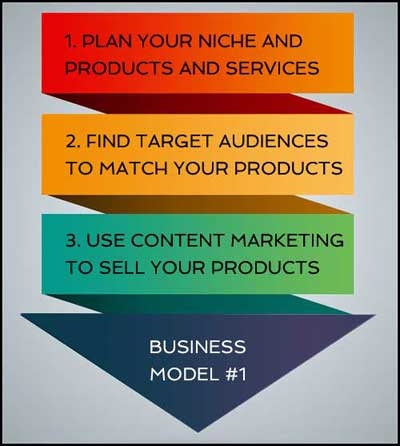
Your blog – and your Content Marketing as a whole – becomes the vehicle of your selling process. You regularly publish and promote valuable articles that inform, guide, advice and mentor people on your niche topic, so that you become a go-to resource for both information and products in your space.
Here, in this model, Content Marketing supports the sale of predetermined products and services.
b. The Business Model To Follow When You Don’t Know What You Want To Sell
The second way to work on Knowledge Commerce can be followed by marketers who have no idea yet on what they want to sell as products and services. But they still want to get started with Content Marketing (for its own benefits in audience-building).
You decide on a niche you are attracted to, and start writing blog posts and other content with a view to build a “community” of loyal subscribers. The idea here is not to sell anything yet, until you have wooed enough targeted subscribers to opt into your mailing list. Here, in this model, your aim is to cultivate of a “Minimum Viable Audience” (or MVA).
What is a Minimum Viable Audience? It’s the least number of subscribers you need, who can give you quantity and quality of feedback on how you can serve them better. If you were to survey them, their responses should be reliable and dependable.
You build enough subscribers to tell you the products they want so that it makes any selling effort, of anything in your niche, risk-free and cost-effective.
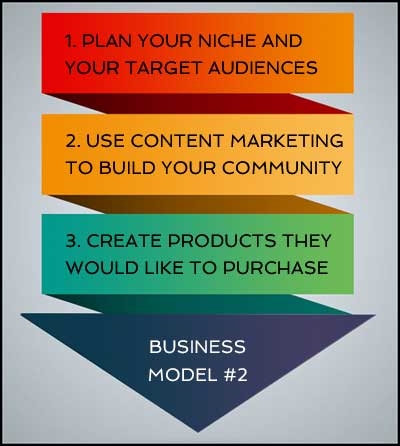
Your subscriber list is your veritable goldmine. It not only builds a bonded community for your Content Marketing, but also converts readers into fans and avid followers, who increasingly trust you.
In this business model, once you have built a solid franchise with an audience that laps up your every word, you can then plan what you’d like to sell to them. Often, they will show you the way themselves, for you will learn their tastes and preferences first hand.
c. The Big Pros And Cons Of These Two Alternative Business Models
Pros And Cons Of Business Model #1:
The big advantage with Business Model #1 is that you get your product creation over with upfront. You are then free to focus on your Content Marketing without distraction. Business Model #1 works when your target audiences are people like yourself – or of your own ilk. Since you know well what products you’d buy, your guesswork on behalf of audiences may work well too.
But on the flip side, you do take a risk. You decide to create all products without any hint from your audiences on what they like to buy. If your audiences are not exactly like you, it’s a gamble.
That said, however, you have one very great entrepreneur in your corner, who believed it is never necessary to ask an audience before creating a product. That great entrepreneur was Steve Jobs. Here’s what he always said:
Some people say give the customers what they want, but that’s not my approach. Our job is to figure out what they’re going to want before they do. I think Henry Ford once said, “If I’d asked customers what they wanted, they would have told me a faster horse.” People don’t know what they want until you show it to them. That’s why I never rely on market research. Our task is to read things that are not yet on the page.”
Pros And Cons Of Business Model #2:
There is no seeming risk attached to Business Model #2 because you get your product ideas from your own loyal readers of your blog. The problem here, though, is one of finding enough bandwidth later to make your products. You have to continue with content marketing, while also creating your products. That can be tough.
Brian Clark, Founder of Copyblogger, made his millions by this second model. Clark says he owes much of his success to the power of listening to his audience’s desires. He then built products to satisfy those desires.
So did Joe Pulizzi, the ultimate guru of Content Marketing. Joe is an evangelist of this second type of business model. He writes in his book “Content Inc.”:
Through a lovely accident, I stumbled on a powerful way to build a business in the digital age – and now believe there is no better way to go to market. By focusing on building an audience first and defining products and services second, an entrepreneur can change the rules of the game and significantly increase the odds of financial and personal success.
Let me repeat that: I believe the absolute best way to start a business today is not by launching a product, but by creating a system to attract and build an audience. Once a loyal audience is built, one that loves you and the information you send, you can, most likely, sell your audience anything you want.”
Now that you know the pros and cons of both the above business models, you can decide which “guru” to follow.
2. Different Ways To Sell Your Knowledge Directly As Products And Services
In addition to choosing one of the broad models to follow for your business, you have to pay a little more attention to whether you want your knowledge content and products to earn money themselves – or earn money from other supportive forms of revenue, such as ad revenue.
Let’s first look at three ideas where your knowledge products earn money themselves in different ways …
a. Gated or Paywalled Knowledge Content That Can Earn Money For You
You may have often come across the concept of “gated content” or “paywalled content” accessible only to paying members. The idea used in such cases is to offer some content free. But if people want to read more (or watch videos of the really worthwhile actionable stuff), they have to pay to see the rest of the content.
Here’s an example of the ReflexionYoga site where some basic yoga asanas are shown free, while others have to be paid for as a monthly membership.

Remember one thing, though: marketers can charge payment in many ways. Sometimes marketers sell premium content for a monetary fee. Sometimes, they may ask you to give your name and email address in exchange for some “gated content”. And sometimes, it’s as simple as “Please pay with a Tweet to proceed and read the rest of this article”.
b. Service or Knowledge Productized To Use As Saleable Content
We’ve all seen plenty of examples of ebooks, templates, courses, licensed content and other “info-products” being sold via ecommerce. A lot of businesses that have good topic depth in their niches, are tempted at some time or other, to sell their knowledge as “packaged content”.
In fact, a lot of consultants too have found that rather than limit themselves to four of five clients a month (whom they can physically service), they can “productize” what they know as courses, software or apps, that can become sources of “passive income” i.e. they can sell at scale, endlessly, night or day, 24x7x365, even as they sleep!
One small business example I love to tell people about is Sweater Babe. See their site below:
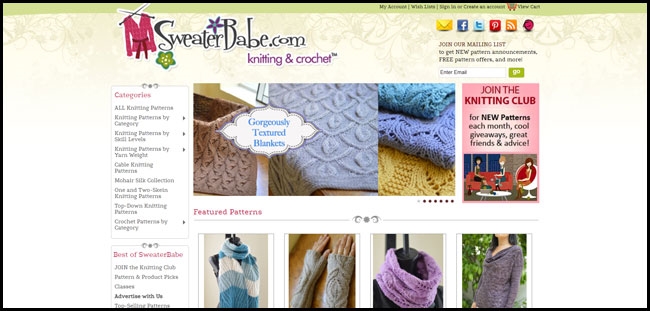
It’s a simple enough idea set up by an entrepreneur who loves knitting. The owner’s creativity is “productized” as content – largely knitting patterns. But see this wizardry … when you buy the knitting patterns you’ll also end up buying the wool and the knitting needles, and when you have leftover yarn, you’ll buy more knitting patterns.
Readers of the site soon can’t tell if they’re shopping for the “knowledge content” or the secondary products.
c. Knowledge Content Used To Monetize Authority And Eminence
One of the advantages of Knowledge Commerce is the fact that you can build your brand eminence also side by side when you sell content with depth and authority. See the site of the Content Marketing expert Jeff Bullas below.
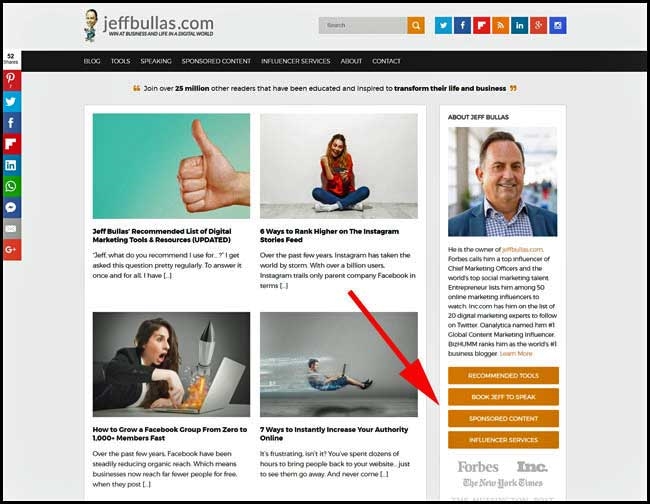
Notice how he is able to monetize his content as ebooks and courses, and also selling his “influence” e.g. Recommendations of Tools, his Speaking Engagements, his Influencer Services and through the Sponsored Content he allows big brands to post on his site, which he annotates.
He gets the price he asks for as an Influencer as a result of his content being so popular (he gets 25 million annual visitors to his site, and has 700,000+ followers on social media and more than 70,000 email subscribers).
3. Different Ways To Use A Free Knowledge Platform That Attracts Other Revenues
There can be three ways by which knowledge content can create the background – or milieu – while products related to the content can piggyback on the content and be sold.
Here are some examples of how this works …
a. Free Knowledge Content Supported By Ad Revenues
There are now lots of ways in advertising is insidiously mixed in with knowledge content so it’s hard to separate the two. Just a small example below from a blog post, shows at least six areas where ads have been inserted, sometimes looking like ads, and sometimes looking like editorial content.
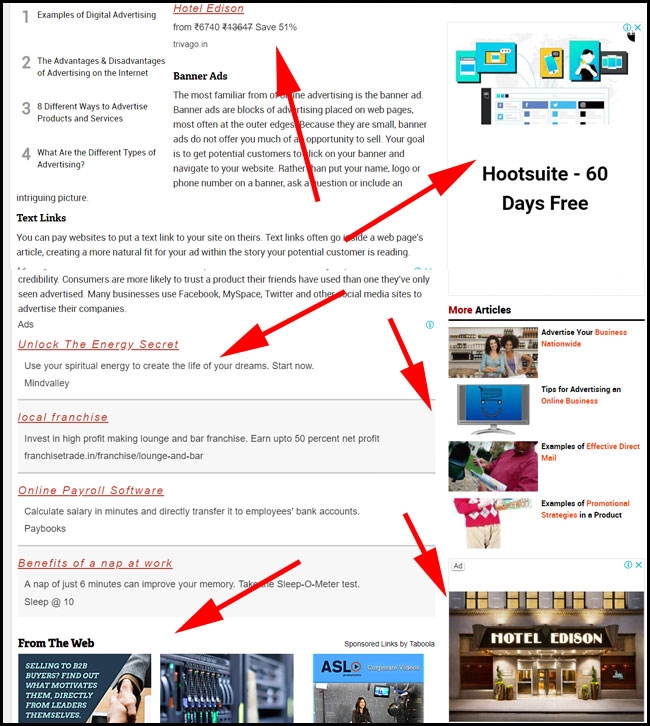
Some bloggers, for instance even include paid-for links to products, as part of their external links. These editorial links look natural in the content, but still earn money on the side. The moot point, though, is whether by allowing any form of insidious advertising, you are eroding content credibility and value – and earning short-term bucks while losing long-term trust.
Some knowledge marketers think it’s okay, as long as the ads are relevant to the article they are situated in, and contribute some extra value to the content. Ultimately, with respect to the quality and quantity of in-content or with-content ads you allow, it’s a call you have to think hard about and take.
b. Free Knowledge Content Supported By Affiliate Product Sales
Unlike in the case of advertising, the content industry as a whole is very supportive of “affiliate marketing” – even if affiliate marketing is indeed one form of subtle advertising. Below is an example from Wirecutter.com where an author, in order to recommend an affiliate product (Bluetooth speakers) has written a “review article”.
Whether the article idea sparked the inclusion of an affiliate product – or the affiliate product sparked the idea of the article – is irrelevant. In the rules of the affiliate marketing model, all’s okay if it’s a good article, and it’s a good product – and the author earns good money.
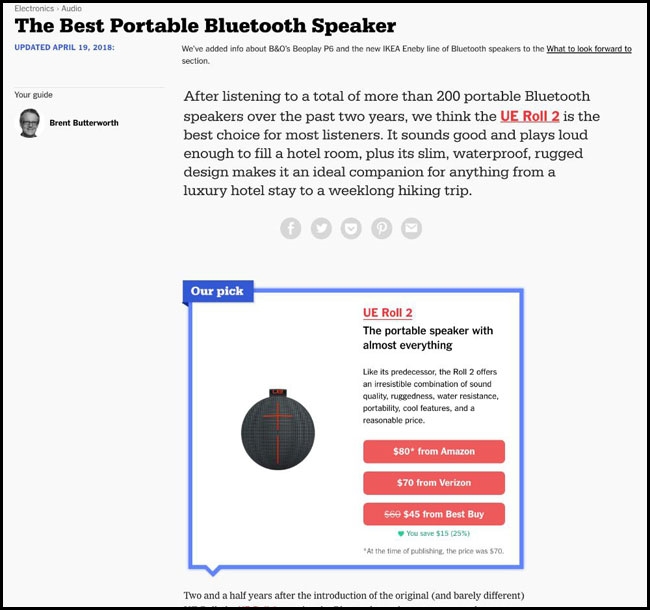
Affiliate marketing revenue can be earned tastefully and elegantly – it also be crass at times. All depends ultimately on who is recommending a product, and whether the author recommending has credibility, and the product too does.
Many content-creators believe their credibility will be enhanced if they make a disclosure that sounds sincere – like this: “I must mention I am an affiliate of this product, but I would never recommend something I don’t myself use. I would only vouch for a product I can lay my personal credibility and reputation on the line for.”
c. Earning From Allowing Guest Posts Or native Advertising On Your Blog
These days several content marketers want to “guest post” on other people’s sites – for publicity, traffic or backlinks. Many marketers have taken to charging for carrying guest posts on their sites. Often that’s not just a way to earn, but also to filter out too much badgering by wannabe guest-posters. If done with the right intentions, though, it’s not wrong to charge people for wanting to write posts on your blog.
Apart from individual guest-posters, there could be big brands wanting to post “native advertising” on your site for a tidy sum they’ll pay. (Sometimes this is also known as “Sponsored Content” or “Branded Content.”)
Native advertising is the use of paid ads that match the look and feel of the site on which they appear. Native ads are designed deliberately to look like part of the editorial flow of the page on which they sit. In the old days of printed magazines, such content used to be known as “advertorials” (advertisements for brands that look like editorial pieces).
For instance, look at the sponsored blog post below in the Gawker (before it closed down). It looks so much like Gawker’s own style of writing. But it’s actually a post written by a television drama series to advertise their premiere on TV. Notice the second arrow pointing to the small tag above the post that says “SPONSORED”.
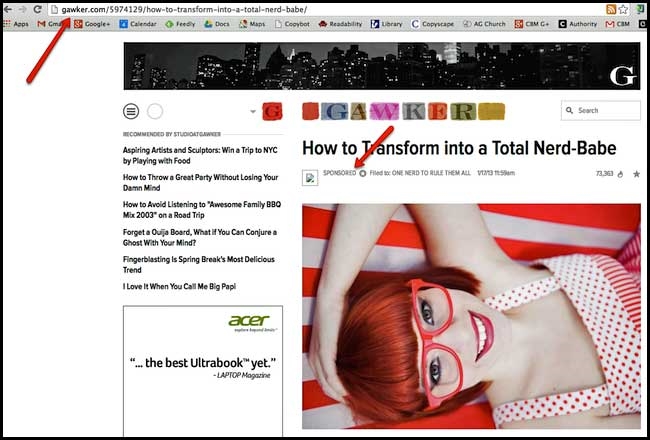
If the brands you allow to post on your site are truly credible ones, and relevant to your niche and audiences, they can give you a positive rub-off. Branded content may work both for your earnings, and to enhance your own brand value.
In Summary …
- Your ideal business model is the way you choose to make money through your products or around them.
- What is a business model? It’s the strategy and process you will follow to make money from your business.
- As solopreneurs, we have to decide on our ideal business models depending on our goals and target audiences.
- You can choose from alternative Knowledge Commerce models based on your knowing, or not knowing, what to sell.
- You can explore the different ways to make knowledge content create revenues from the sale of itself.
- You can also examine the different ways to enable free knowledge content to raise revenues around itself.
So What Are Your Thoughts? Do Share!
This post is incomplete without your input. The community of Knowledge Commerce solopreneurs would feel galvanized to hear from you … so do share your thoughts on this topic with us, in the comments field below this post.
Business & Finance Articles on Business 2 Community
(68)
Report Post





